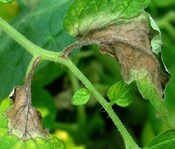The Cornell Department of Horticulture blog today offers “10 tips for gardeners to beat late blight.”
Earlier this week, state Agriculture Commissioner Darrel J. Aubertine alerted gardeners and commercial growers of the possibility of late blight again this year.
“The exceptionally cool, damp spring we are experiencing throughout New York State this year heightens our concern for late blight,” Aubertine said in a news release. “We saw the devastation it can do to a tomato crop in 2009, and we have already received reports of early late blight detection in neighboring states.”
While late blight has not been detected in New York at this time, it has been detected in Michigan, Connecticut and Maine.
“Last year, the Department initiated a concerted strategy to enhance the State’s detection and eradication efforts that involved training its horticultural inspectors, surveying plants at the retail level and in commercial greenhouses, and working with Cornell Cooperative Extension to conduct outreach and follow up in the field with growers and gardeners,” the Ag and Markets news release said. “This year, inspection of tomato plants has been a priority, and to date, more than 150,000 tomato plants have been inspected with no signs of late blight detected.”
The Cornell Horticulture blog offers the following 10 tips for gardeners to beat late blight:
Kill volunteer potatoes. Dig up, bag and trash any potato plants that pop up in your garden or compost pile. It may take repeated efforts to get them all.
Buy healthy tomato plants. Learn what late blight looks like. If you spot any infected plants while shopping, alert store management and your local Cooperative Extension office, and buy your plants somewhere else. Or you can grow your own plants. (Late blight isn’t spread on tomato seeds.) Start seed about 6 to 8 weeks before your last frost date.
Use certified seed potatoes. Don’t use leftovers from last year’s garden or table stock from the grocery store.
Keep plants dry. The late blight pathogen thrives in cool, wet weather. That’s because it requires moisture to infect plants, grows best when it’s cool, and clouds protect spores from lethal UV radiation when they are dispersed by wind. Even in absence of rain, the pathogen can infect plants if the relative humidity is 90 percent or more. If plants need watering, water the soil – not the foliage.
Be vigilant. Inspect plants at least once a week – more often if weather is cool and wet. Immediately remove and bag foliage you suspect might be infected. While late blight symptoms are distinctive – dark brown lesions on stems and leaves with white fungal-like growth developing under moist conditions – it’s possible to confuse it with other diseases. Your local Cooperative Extension office can help you with identification.
Act quickly. If symptoms continue despite removing infected foliage, consider removing plants entirely – sooner rather than later. “It is rarely possible to control late blight just by removing affected tissue,” says Dr. Meg McGrath of Cornell University's Department of Plant Pathology. “The longer you wait to remove plants, the more spores your garden sends to the wind to infect other gardens and farm fields.”
Sound the alert. If you find late blight in your garden, let your gardening neighbors and local Cooperative Extension staff know so they can warn others and be on the lookout for additional infestations. Make sure your neighbors know how to spot late blight in their own gardens.
Dispose of plants properly. To reduce disease spread, remove infected plants during the middle of a sunny day after leaves have dried, if possible. But don’t wait for these conditions. Seal plants in garbage bags and leave them in the sun for a few days to kill plants and the pathogen quickly before placing in the trash or burying underground or deep in a compost pile. Don’t just leave plants on the ground or on top of the compost pile where they will continue to be a source of spores until the plant tissue dies. With a large number of plants, you can build a pile on the ground and cover securely with a tarp until the plants die.
Keep an eye on other tomato-family plants. Some strains of late blight can infect other tomato-family plants, including weeds such as hairy nightshade and bittersweet nightshade. Control them early so that late blight on these plants doesn’t go unnoticed. Petunias and tomatillos are also vulnerable to attack.
Use fungicides with care. Fungicides can control late blight. (Chlorothalonil and copper-based products are both available to home gardeners.) But if you wait until late blight symptoms appear, it might be too late to rescue plants. For fungicides to work effectively on late blight requires a regular preventive spray schedule and thorough spray coverage. Follow all label directions, including use of respirator, waterproof gloves and protective eyewear.
To learn more read the Cornell Horticulture blog entry Late blight update. Also read the Ag and Markets news release Commissioner Alerts Growers to Potential for Lake Blight.




